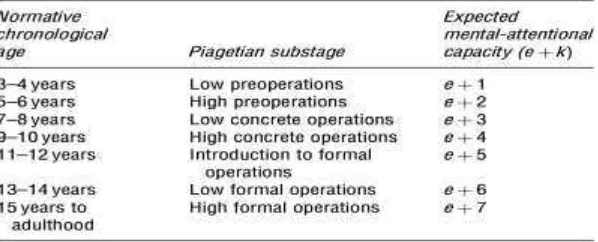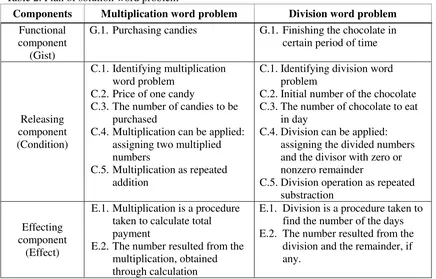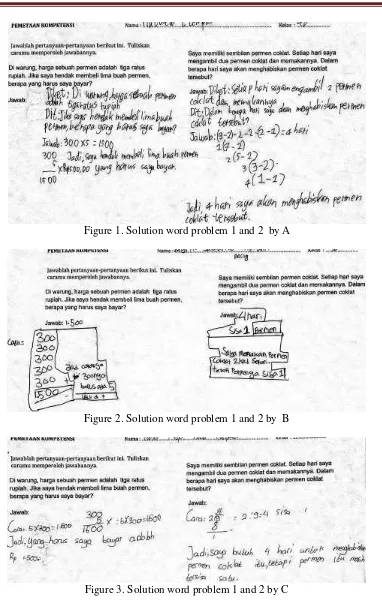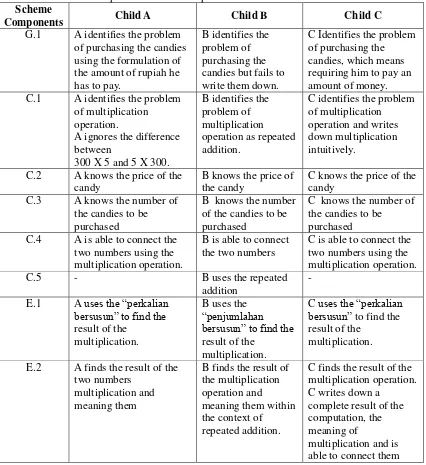INTERNALIZATION OF MULTIPLICATION AND DIVISION CONCEPTS IN
A NEO-PIAGETIAN PERSPECTIVE
Helti Lygia Mampouw1,2, Agung Lukito1, St. Suwarsono1 1
) State University of Surabaya 2
) Satya Wacana Christian University, Salatiga
Abstract
In cognitive development context, scheme is conceived as the unit of analysis of cognitive processes. Pascual-Leone as a neo-Piagetian explains cognitive development by combining the information-processing theory and Piagetian theory. In his theory, the Theory of Constructive Operators, Pascual-Leone proposes the scope of scheme and offers operators as constructs schemes. Constructed schemes can explain internalization. This paper describes internalization of multiplication and division concepts is experienced by 9-year-old children, in the theory of constructive operators as a neo-Piagetian perspective.
Keywords: theory of constructive operators, scheme, multiplication, division
INTRODUCTION
Concepts are constructed inside a child’s mind when they interact with their environment.
During play, children are practising multiplication when, for instance, two kids, each of them, bring five marbles with them, or when they pay a sum of two thousands rupiah for two sets of playing cards because each card costs them one thousand rupiah. Children also know division
since they know that ten thousands rupiah would get them two portions of “bakso” since a
portion of bakso is five thousands rupiah. In the same way, following a rule of a game, a collection of stones are divided to four children, each of them receives three stones, the rest is set aside. Their motivation to stay actively involved in every game/activity is a stimulus for children to have good mathematical skills. Consequently, multiplication and division concepts will develop along with their cognitive capacity as they learn the concepts and understand hem.
Internalization, in general from Wikipedia, is the process of consolidating and
embedding one’s own belief, attitudes, and values when it comes to moral behavior.
Internalization is not verbatim, but substantive (Moreira, 2011). Internalizing multiplication and division concepts refers to a process of how such concepts are understood, organized and able to be used according to the scheme of the concept the child (individual) develops so they are applicable to the reality. Indicators marking this internalization of the multiplication and
division concepts are observed through the children’s problem-solving activity. Their memory capacity will influence how children process each incoming information, both when they localize their problems and when they complete their calculation.
Pascual-Leone, one of the neo-Piagetians, states that the scheme the child develops is greatly corresponded to their cognitive capacity. There are operators that help construct this
scheme that work in compliance with the child’s subjective situation. Pascual-Leone proposes the Theory of Constructive Operator (TCO) to segregate the role of each of these operators that operates once the scheme of these concepts are developed. These operators are categorized into two levels, the subjective operators and the metaconstruct operators.
ME-238
particularly TCO, takes place through these constructed scheme. This is observable through the use of task-analysis in the form of word problem. The objective of this paper is to describe the internalization of the multiplication and division concepts using the subjective operators and metasubjective operators according to TCO. The operation of multiplication and division concepts internalization is observed on 9-year-old children, who are in their 4th grade of primary school. Word problem is given using the integer number. This paper is expected to
contribute to the development of child’s cognitive in terms of their readiness to learn multiplication and division. A teacher could tell when a child is ready to learn a new concept or at what particular age/grade he/she could understand and implement a math concept. This
impacts on the design of the child’s learning activity, on the appropriateness of the problem selection, and particularly, on the formulation of the learning goals.
COGNITIVE DEVELOPMENT: FROM PIAGET TO NEO-PIAGET.
Cognitive equals to brain activity, thinking or using the mind or mental process. Maitlin (1998) states that cognition or mental activity involves the acquisition, storage, transformation, and use of knowledge. Cognitive development refers then to the changes/transformations of thinking (Woolfolk, 2009). According to Woolfolk, there are three general principles operated in
one’s cognitive development—they develop at different phase, sequentially and gradually. In his teory, Piaget proposes a cognitive development that associates with specific age limits. Biological maturity is the primary variable of cognitive development. Piaget divides level of cognitive development into four stages: sensorymotor (0-2 years old), preoperational (2-7 years old), concrete-operational ((2-7-11 years old) and formal-operational (11-adult). Piaget claims that individual ability in each of these levels is the result of cognitive development process that occurs naturally. The process of cognitive development is the result of a series of related assimilations and accommodations. Conceptually, cognitive development and growth proceeds in this fashion at all level of development from birth to adulthood (Schunk, 2012; Bickerton, 2000).
Since 1960s until today, Piagetian theory of cognitive development appeals many people. This theory has become research material and there have been numerous researchers and practitioners developing his theory towards specific domain of their expertise. A group of researcher-theorist known as neo-Piagetian seeks to maintain some assumptions Piaget holds, while in the same time developes a framework illustrating the process of child’s concept development and ability in a specific domain of knowledge. For example, Juan Pascual-Leone, Robbie Case and Graeme Halford integrate Piaget theory with information processing theory. They believe that the processing capacity corresponds to the stages of the cognitive development. Kurt W. Fisher associates Piaget theory with learning theory and socio-cultural theories of development. Andreas Demetriou relates the influence of the tradition of differential psychology and the influence of the cognitivist tradition to Piaget theory. In general, Bickerton (2000) records that there are three primary differences between Piaget theory and neo-Piagetian theory, which are related to the nature and development intra stage, transitional inter stage and the social interaction role in each stage.
THE THEORY OF CONSTRUCTIVE OPERATORS
in some task. The functional collections epistemologically correspond to psychological schemes (Pascual-Leone et.al, 2010). Scheme refers to a concept or framework that exists inside one’s mind used to organize and to interpret information (Santrock, 2011).
One’s cognitive develops when the schemes develop following their cognitive capacity.
According to Piaget, cognitive development takes place through the assimilation-accommodation process. The assimilation process occurs when the internal cognitive structure receives new information (external reality) after being adjusted to suit the cognitive structure. The accommodation process comes about when new information triggers the adjustment of the internal cognitive structure to suit the information. Assimilation or accommodation processes continue until the state of equilibrium of internal structure has over the new information is established. In a state of equilibrium, new scheme or complex schemes have been developed.
To achieve such equilibrium, activating the coordinated schemes is required. Based on their types, schemes are divided into figurative and operative schemes. According to Morra et.al (2008), a figurative scheme represents in the mind such as object, configurations, concepts, meanings, and mental state. While, an operative scheme represents actions, process, operations, and transformations that one state generates another. Pascual-Leone et.al. argues that when an operative scheme applies on a figurative scheme it change some figurative characteristic, thus setting condition for a different figurative to apply and represent the outcome. An executive scheme will coordinate and control the figurative and operative schemes performance through planning an action (Pascual-Leone et.al., 2010).
To widely the scheme concept Piaget has proposed, Pascual-Leone and Johnson (2012) define a scheme as a dynamic coordination of three components: functional, releasing and effecting components. Functional components assign the scheme gist and the expectancies of an outcome. Releasing component is made-up of a set of conditions that, even if minimally
satisfied, initiate the scheme’s activation. Effecting scheme consists of the effect of its
activation. Therefore, to execute a scheme would require a start from an objective setting and outputs expected, strategies to help achieve them and a number of information that will be formulated using the selected strategy to achieve the objective.
Pascual–Leone develops two level constructs to highlight the cognitive development in an individual. The first level is called subjective operators and the second is metasubjective operators. Subjective operators are the scheme found in situational-specific construct. It signifies that people are specifically identified with their own mind, who develop their own scheme based on their own experiences. Metasubjective operators are situational-free operators since they do not contain their own information. These operators are located inside the brain and operate on subjective operators. As in how a computer works, subjective operators are identical with softwares; while metasubjective operators are identical with hardwares.
Metasubjective operators are often called the hidden operators since they work inside
people’s brain. Each and every operator has their own individual responsibility, and yet perform
their job simultaneously once the scheme is activated. There are two hidden operators that are relevant to discuss here – the Mental operator (M) and the Learning operator (L).
ME-240
developmental variable k and put them into equation of cognitive capacity: M = e + k. The constant e represents the executive scheme and k the number of operative and figurative scheme that can be activated simultaneously. Table 1 contains the different values taken by M.
Table 1. Chronological age of Piagetian processing substages and predicted mental-attentional capacity
source: Pascual-Leone et.al. 2012, p.535.
L operator is an operator that reflects automatization in the scheme activated. Morra et.al. (2008) notes that if one introduces learning phases, that automatize the activation of a scheme or coordinate previously separated schemes, the L operator will replace or cooperate with the M operator, thereby facilitating the task to a degree corresponding the number of scheme involved. From the L operation, logical-structural operator (L-structure) is obtained, which then is known
as an operator that activates the scheme automatically due to one’s logical-structural role.
MULTIPLICATION AND DIVISION OPERATIONS
Addition, subtraction, multiplication and division are basic operations in mathematics. Addition and subtraction are operations that children learn first. Intuitively, multiplication is developed from addition and division is developed from subtraction. Traditionally, instruction in basic operations in primary school has focused on learning the operations fact and developing computational facility.
Multiplication is learned through three situations: scalar multiplication, array problem and combinatorial. Scalar multiplication is applied in the situation, where there is a group of numbers that each of these numbers hold equal amount of group of numbers. A research report by Fischbein et.al (1985) in Pascual-Leone et.al. (2010) responses to such problem, children’s intuitive notion of multiplication as repeated addition, when at least one number is an integer.
Two types of division are sharing or partitioning and grouping. Dividing 20 books to ten children and grouping 20 books each into a group of two books are examples of different application of division. Connecting the two types of divisions and associating them with the three basic operations will stimulate the formation of connection scheme among basic operations.
INTERNALIZATION OF MULTIPLICATION AND DIVISION
1. In a store, 1 candy costs three hundreds rupiah. If I buy five, how much will the five candies cost?1
2. I have nine chocolate candies. Every day I take two candies and eat them. How many days will I finish all the chocolate candies?
The solution as dynamic coordination among scheme components is presented in table 2.
Table 2. Plan of solution word problem
Components Multiplication word problem Division word problem Functional
component (Gist)
G.1. Purchasing candies G.1. Finishing the chocolate in certain period of time
C.3.The number of candies to be purchased
C.2.Initial number of the chocolate C.3.The number of chocolate to eat
in day
C.4.Division can be applied: assigning the divided numbers and the divisor with zero or nonzero remainder
E.2.The number resulted from the multiplication, obtained through calculation
E.1. Division is a procedure taken to find the number of the days E.2. The number resulted from the
division and the remainder, if any.
The solution word problem plan involves the figurative and operative schemes arranged and controlled by the executive scheme. The formation of the scheme is begun with problem identification (C.1). The flow of the word problem activates the concepts of the operations(C.4 and/or C.5) that have been learned. The multiplication connects two numbers, in this context were the number of candies to be purchased and the price of each candy. The division relates the initial number of the candies to the number of the candies to eat every day (C.2 and C.3). Since C.2 and C.3 are input numbers, both are categorized into figurative schemes. Operative scheme works on the figurative scheme, transforming the existing information by following the assigned procedures. E.1 is an action scheme carried out in response to C.1 through C.5 under the control of G.1. The multiplication action scheme is:
(total payment) = (price of one candy) (the number of candy to be purchased) . . . (1) and the division action scheme is:
1Adapted from word problem: “today at my store 1 candy costs 5 cents. How much will 3 candies cost?”
ME-242 . . . (2)
Equation (2) derived from:
(numbers to be devided) = (division result) (divider) + (remainder) . . . (3) The E.1 action is directed by C.4 that functions as parameter of the operative scheme. C.4 is identified as a parameter since when it is applied to the figurative scheme, it will function as the structural condition for the operative scheme in achieving the target (goal) set-up in G.1. Children operating C.5 are rated as having the cognitive capacity that is one-level higher than those operating the C.4. The E.1 action scheme leads to find quotient numbers. Different from multiplication, division is not commutative. Therefore, it requires greater amount of mind coordination to be able to differentiate numbers to be divided from devider. The division action scheme is feasible after the functions of both numbers are identified. Division with nonzero remainder is slightly more difficult to perceive than the zero remainder one. Interpretation of the resulted numbers is being adapted to the problem of the word problem.
Some of the hidden operators are involved in the internalization of multiplication and division concepts. These operators work simultaneously. The operative scheme of the total payment and the eating-chocolate-till-finish are activated by the M-capacity, which is made possible by the cognitive capacity of the child. After L-structure is operating, M-operator will activate the structure identification (C.1) upon reading the word problem. This structure identification stimulates the activation of the operation scheme, which is applicable to the problem (C.4 and/or C.5). The activation of C.2, C.3 and E.2 is being boosting by M-operator. The L-structure stimulates simultaneous and interconnected activation between the multiplication/division scheme that has been learned and which is applicable, identifies the figurative schemes C.2 and C.3 as the numbers being operated, and the number scheme as the result of the operation. The C.4 in division word problem activates a new scheme on the implication of the division remainder. The limits of M-capacity has kept most children from using repeated addition or repeated substraction.
INTERNALIZATION OF MULTIPLICATION AND DIVISION CONCEPTS BY PARTICIPANTS
The selected participants consist of 3 children in grade 4 of primary school and are 9 years old. They are given papers containing word problems and are instructed to write down the solutions on the same papers. Interviews, as complimentary element of the written information,
are conducted after assessing these three children’s works. The following pictures show their
Figure 1. Solution word problem 1 and 2 by A
Figure 2. Solution word problem 1 and 2 by B
Figure 3. Solution word problem 1 and 2 by C
ME-244
demonstrate that each of them is unique. Table 3 and table 4 are the internalization result of the three participants. Data collecting by interviews are using symbol (*) at the end of statement.
Table 3. The scheme components of the word problem 1 solution. Scheme
Components Child A Child B Child C
G.1 A identifies the problem of purchasing the candies C.1 A identifies the problem
of multiplication
The A, B, and C’s reactions to the word problem demonstrate their uniqueness. Other than what
has been shown in table 3, the following is comparation made on the internalization of the multiplication concept found in these three children.
2. A, B and C successfully establish the price of 1 candy and the number of candies purchased, where both of the numbers are connected through a multiplication. B chooses to use the
repeated addition, A and C use the “perkalian bersusun”.
3. The three children make similar conclusion regarding the application of the multiplication
operation on the two numbers. Although A and C are both using the “perkalian bersusun” to
find the result, yet A fails to understand meaning of the multiplication, while C is able to relate the result of the operation to its meaning. A writes 300 X 5 = 1500 shows that his understanding of the multiplication concept is unrevealed merely because in the word problem 300 is written prior to 5. Moreover, because A knows that there is a commutative nature in the multiplication operation(*). C remains persistent about what multiplication operation is and consistently writes 5 X 300 both when modelling the multiplication and
when summarizing the result of his computation. B, who uses the repeated, “penjumlahan bersusun lima” addition also correctly writes the meaning of the multiplication as he has done it when doing the calculation.
4. Both A and C write down their result summaries. The result of the computation is put back to the reality after some abstraction and calculation process. Whereas B knows the meaning of the computation, yet fails to write down the interpretation(*).
Table 4. The scheme components of the word problem 2 solution Scheme
ME-246 of the repetition. A
treats each result of the substraction equally the same
down only the result multiplication. C is unable to write the division concept they undergo. Others than shown in table 3, the following is the comparation of the internalization of the multiplication concept by the three children.
1. A, B and C understand the word problem given and successfully identify them as the problem of division operation. Specifically, A and B(*) mention it as problem of repeated substraction.
2. A, B and C successfully determine the initial number of the chocolate candies as the number to be divided; and the number of the chocolate candies to eat every day as the divisor . Both numbers are connected through the division operation and the repeated substraction. B does not write them down since she can calculate them on her mind(*). A and B choose to use the
repeated substraction, while C uses the “pembagian bersusun”
3. The three of them find both the result and the remainder of the division.
4. The three of them draw their conclusion from the result of the division. A applies the substraction using an equally the same number in the remainder of the division, but on the final part, substracts the remainder of the division to obtain zero remainder. Interestingly, A counts the number of the repeated substraction based on the nonzero remainder division, and treats it as the number of days required to finish the candies. B, not used to the nonzero remainder division(*), gets confused with the result of his computation. C uses the ordered-pair to count both the result and the remainder of the division, yet he fails to put them into an equation. The three of them can conclude the number of the days to eat two chocolate candies as the solution word problem, but they perceive the remainder of the division differently.
CONCLUSION AND SUGGESTION
The observation on the internalization of the multiplication concept through the word problem has successfully identifed the schemes and operators constructed according to each of their individual roles. According to TCO perspective, activation of the hyperactivated schemes by the M-capacity is largely related to the development of the child’s cognitive capacity (M-capacity).
Nine years old children undergo an internalization of multiplication and division concepts quite uniquely. The internalization of the multiplication concept works quite well; while the internalization of the division concept requires additional operative scheme to avoid doubts in dealing with the remainder of the division.
The internalization of the multiplication and division concepts found here provides
information on children’s readiness to learn multiplication and division. As for Pascual-Leone
theory’s relatedness to learning, Cortez (1982) states that the teacher’s job is to improve the size
and the amount of information so the individual can control, handle and develop the executive scheme in their work.
However, result shown here does not reflect such capacity yet, however it is indicated that
perhaps there some limit related to the child’s capacity, which is presumably associated with
their insufficient cognitive capacity, in that they are unable to process larger amount of information.
BIBLIOGRAPHY
Bickerton, Gillian. 2000. Children’ Understanding of Scientific Concepts: A Development Study. Canada: The University of British Columbia.
Cortez, James A. 1982. Class Size Neo-Piagetian Testing: Theory, Result and Implication.
Master’s Thesis. University of North Florida.
Demetriou, A. 2000. Neo-Piagetian Theories of Cognition Development. In
www.academia.edu/2090948/Neo_Piagetian_theories_of_cognitive_development ,
access January, 11 2014.
Matlin, Margaret W. 1998. Cognition 4ed. New York: Harcourt Brace College Publishers.
Moreira, Marco Antonio. 2011. Why C. 1991. Why Concepts, Why Meaningful Learning, Why Collaborative Activities and Why Concept Maps? (¿Por qué conceptos? ¿Por qué aprendizaje significativo? ¿Por qué actividades colaborativas? Y ¿Por qué mapas conceptuales?). Aprendizagem Significativa em Revista/Meaningful Learning Review – V1(3), pp. 1-11.
Morra, S., Gobbo, C., Marini, Z., Sheese, R. 2008. Cognitive Development: Neo-piagetian Perspectives. New York: Erlbaum.
Morra, Sergio. 2000. A New Model of Verbal Short-Term Memory. Journal of Experimental Child Psychology 75, p.191-227.
Pascual-Leone, J., Escobar, E.M.R., Johnson, J. 2012. Logic: Development of Logical Operation. In W.Hirstein (section ed.), Encyclopedia of Human Behavior. New York: Elsevier.
Pascual-Leone, J., Johnson, J., Agostino, A. 2010. Mental Attention, Multiplication Structures, and the Causal Problem of Cognitive Development. In Ferrari, M., Vuletic, L. (eds). Developmental Relations among Mind, Brain and Education. Springer.
Pascual-Leone, J. 2000. Reflecting on Working Memory: Are the Two Models Complementary?. Journal of Experimental Child Psychology 77. p.138-154.
Pascual-Leone J., Johnson, J. 1999. Methods of Task Analysis in Cognitive Development. Canada: York University.
Santrock, John W. 2011. Psikologi Pendidikan edisi 2. (terjemahan). Jakarta: Kencana.
Schunk, Dale H. 2012. Learning Theories: An Educational Perspective, 6th ed. (terj.). Yogyakarta: Pustaka Pelajar.
Todor, John, I. 1979. Developmental Differences in Motor Task Integration: A test of
ME-248
Woolfolk, Anita. 2009. Educational Psychology: Active Learning Edition. Yogyakarta: Pustaka Penerbit.




